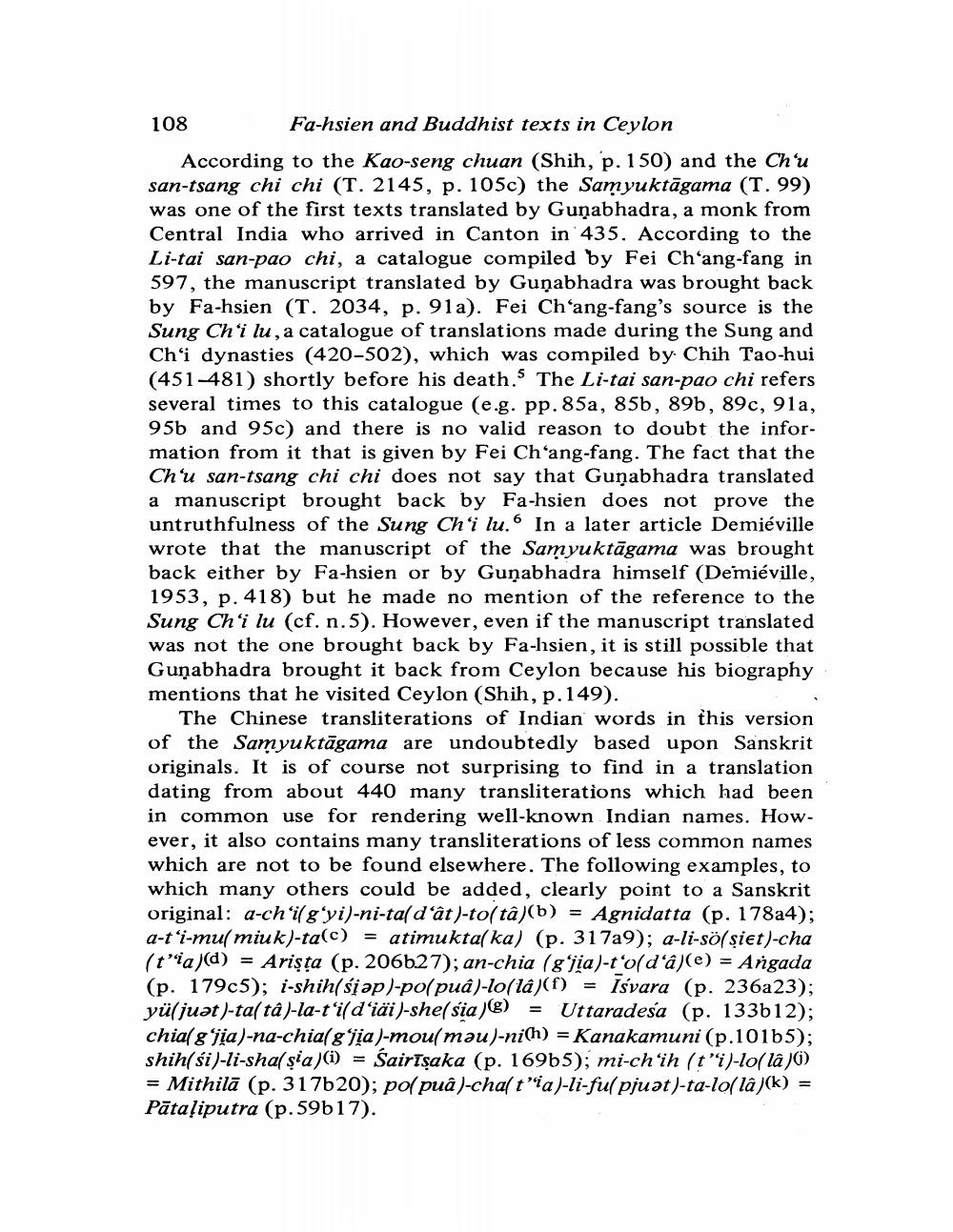________________ 108 Fa-hsien and Buddhist texts in Ceylon According to the Kao-seng chuan (Shih, p. 150) and the Ch'u san-tsang chi chi (T. 2145, p. 105c) the Samyuktagama (T. 99) was one of the first texts translated by Gunabhadra, a monk from Central India who arrived in Canton in 435. According to the Li-tai san-pao chi, a catalogue compiled by Fei Ch'ang-fang in 597, the manuscript translated by Gunabhadra was brought back by Fa-hsien (T. 2034, p. 91a). Fei Ch'ang-fang's source is the Sung Ch'i lu, a catalogue of translations made during the Sung and Ch'i dynasties (420-502), which was compiled by. Chih Tao-hui (451-481) shortly before his death. The Li-tai san-pao chi refers several times to this catalogue (e.g. pp.85a, 85b, 89b, 89c, 91a, 95b and 95c) and there is no valid reason to doubt the information from it that is given by Fei Ch'ang-fang. The fact that the Ch'u san-tsang chi chi does not say that Gunabhadra translated a manuscript brought back by Fa-hsien does not prove the untruthfulness of the Sung Ch'i lu." In a later article Demieville wrote that the manuscript of the Samyuktagama was brought back either by Fa-hsien or by Gunabhadra himself (Demieville, 1953, p. 418) but he made no mention of the reference to the Sung Ch'i lu (cf. n.5). However, even if the manuscript translated was not the one brought back by Fa-hsien, it is still possible that Gunabhadra brought it back from Ceylon because his biography mentions that he visited Ceylon (Shih, p.149). The Chinese transliterations of Indian words in this version of the Samyuktagama are undoubtedly based upon Sanskrit originals. It is of course not surprising to find in a translation dating from about 440 many transliterations which had been in common use for rendering well-known Indian names. However, it also contains many transliterations of less common names which are not to be found elsewhere. The following examples, to which many others could be added, clearly point to a Sanskrit original: a-ch'ilgʻyi)-ni-tal d'at)-tol ta)(b) = Agnidatta (p. 178a4); a-t'i-mu( miuk)-ta(c) = atimuktal ka) (p. 31729); a-li-sossiet)-cha It'ia)(d) = Arista (p. 206b27); an-chia (gʻjịa)-t'o(da)(e) = Angada (p. 179c5); i-shih(si@p)-polpua)-lo(la)(f) = Isvara (p. 236a23); yulju@t)-ta( tan)-la-t'il dʻiäi)-shelsia)) = Uttaradesa (p. 133b12); chial g'jia)-na-chial g'jia )-mous mou)-ni(h) = Kanakamuni (p.10165); shih(si)-li-shalsia)(i) = Sairisaka (p. 16965); mi-ch'ih (t'i)-lo(la)0) = Mithila (p. 317b20); po( pua)-chal t'ia)-li-fu( pjuot)-ta-lo(la)(k) = Pataliputra (p.59b17).




